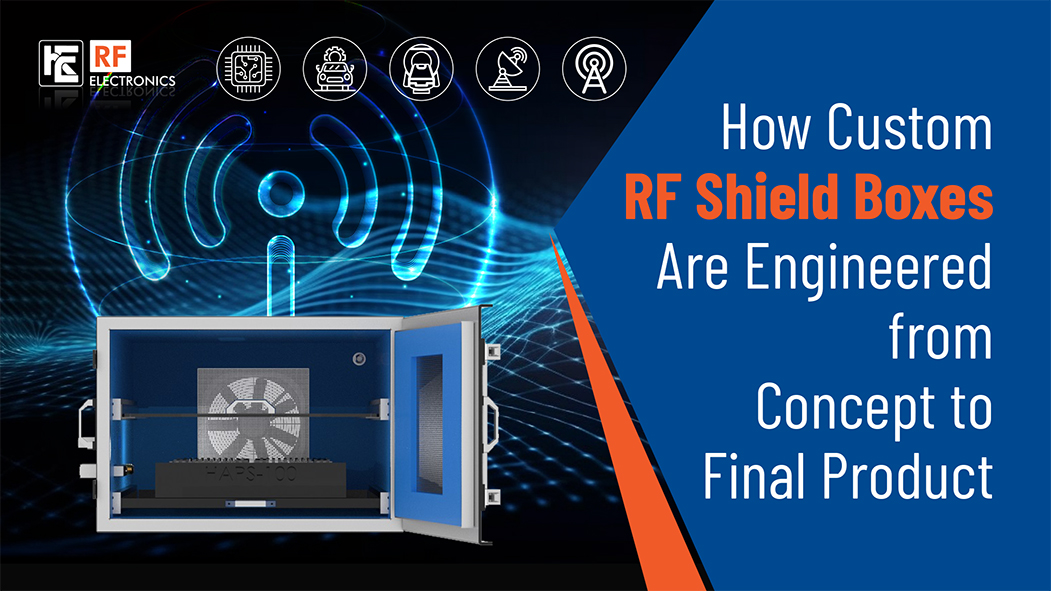Jul 25, 2025

Designing and building a custom RF shield box is a careful journey - starting from initial requirements and ending with a finished product that offers reliable radio frequency control. Here’s how RF Electronics handles that entire process:
Every project begins by understanding what needs protection or measurement. RF Electronics often works with clients in domains such as R&D, EMC, OTA, device testing (Wi Fi, Bluetooth, LTE, 5G), digital forensics, IoT, medical, automotive, and aerospace.
Clients specify dimensions, frequency bands, connector types, and performance goals - such as isolation levels and shielding metrology.
With requirements clear, the engineering team configures a solution using an interactive online configurator. Users create an account, define internal dimensions, add components via drag and drop (e.g. ventilation, connectors, absorbers), then request a quote.
This ensures the unit matches the intended DUT (device under test) - from small wearables to larger equipment racks.
RF Electronics offers various formats: benchtop boxes, rack mount enclosures, standalone mobile units (with caster wheels), and turn table integrated cases.
A rack mount box might be used for server class testing, while a mobile standalone unit may support Bluetooth or 5G DUTs in lab settings.
Focused engineering ensures performance targets are met:
Once the configuration is finalized, fabrication begins. Engineers assemble the shielding enclosure to meet size, material, and connector specifications. Rugged designs help withstand repeated use and transport.
Finished units must meet isolation and performance criteria across frequency bands:
Beyond standalone boxes, RF Electronics offers full turn key setups and test racks:
For the most demanding studies - like OTA radiation patterns or high frequency EMC - they also supply RF chambers or anechoic rooms.
This lets customers scale from benchtop enclosures to full-sized chamber setups using shared engineering methods and standard components.
Every deployed box undergoes user feedback for adjustments - such as adding ports, tweaking foam types, legal compliance, and connector rearrangement.
The configurator makes it easy to iterate on dimensions and add-ons, so labs and manufacturers can evolve their setups swiftly.
Once a prototype is validated, RF Electronics can replicate the design - rackmount or standalone - with consistent quality and turnaround.
Custom units often offer savings over off the shelf options, while retaining required performance. These units are ideal for labs, start ups, universities, and production testing.
From concept through fabrication, testing, and deployment, engineering a custom RF shield box at RF Electronics is a clear, structured process:
1. Define your DUT’s size, frequency, connectors, and test scope.
2. Use the interactive configurator to design a tailored box.
3. Choose form factor and construction style.
4. Specify materials, absorbers, connectors, and mobility options.
5. Build a prototype.
6. Validate isolation and performance.
7. Optionally integrate into full test racks.
8. Deploy and refine based on real world use.
9. Scale production with consistent quality.
Whether performing EMC checks, 5G OTA measurements, or moving test setups between sites, RF Electronics custom RF shield boxes offer dependable, precise, and cost effective solutions. The interactive config tool, combined with modular engineering and proven shielding techniques, ensures each enclosure fits your exact needs - down to dB level isolation, connector count, and heat control - while eliminating guesswork.
For engineers, test labs, universities, or manufacturers seeking precise RF control in testing environments, this process - from requirement gathering to final product - is a reliable blueprint for success.
Previous Blog

How to Calibrate Your RF Shielded Enclosure for OTA Performance Testing?
Learn MoreNext Blog

RF Shielding in Electric Vehicle Charging Stations
Learn More